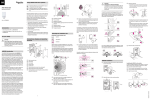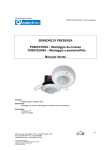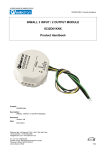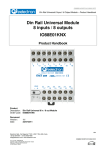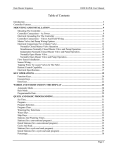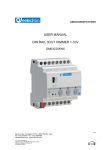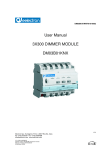Download PRESENCE DETECTORS PD00C03KNX – Inwall
Transcript
PD00C03KNX - INWALL MOUNTING PRESENCE DETECTOR PD00C04KNX - SURFACE MOUNTING PRESENCE DETECTOR Product Handbook ! PRESENCE DETECTORS PD00C03KNX – Inwall Mounting PD00C04KNX – Surface Mounting Product Handbook Products: PD00C03KNX / PD00C04KNX Description: Inwall Mounting / Surface Mounting presence detectors Document Version: 1.1 Date:12/01/2015 Eelectron Spa, [email protected] www.eelectron.com PD00C03KNXFI00020101 Pagina !1 di !16 PD00C03KNX - INWALL MOUNTING PRESENCE DETECTOR PD00C04KNX - SURFACE MOUNTING PRESENCE DETECTOR Product Handbook ! 1. General 4 1. Basics for KNX BUS 4 2. Symbols used 4 3. Function of an occupancy detector 4 4. Detection of movement with the PD00C0xKNX KNX occupancy detector 4 5. Installation Location 4 6. Light evaluation 4 7. Detector operating mode 5 8. Internal logic of detector 5 2. General Settings 5 1. Activate / deactivate outputs 5 2. Test Mode 6 3. Led 6 3. General Settings - Light Control Output 6 1. Common Settings (switch/dimming) 6 2. Additional functions “Dimming mode” 10 3. Additional functions “Switching mode” 11 4. Occupancy-independent dimming mode 11 5. Slave mode of the occupancy detector 12 4. Manual influencing possibilities 12 1. Daylight-depending resetting (semi-automatic mode) 12 2. External influence - Input 12 3. Dimming the lighting manually 13 5. Light sensor settings 13 1. “Send lux value via object” 13 2. Reflection Factor 13 3. Correction value 14 6. Settings “HVAC / Presence - output 1 “ (2,3) 14 1. HVAC channel “Operating mode detector” 14 2. “Light-dependent switching” (Channel HVAC/presence) 14 3. Set value HVAC/presence output 1 14 4. Detector transmits 14 5. Overwrite follow-up time 15 6. Overwrite set value 15 7. Change trigger function 15 Eelectron Spa, [email protected] www.eelectron.com PD00C03KNXFI00020101 Pagina !2 di !16 PD00C03KNX - INWALL MOUNTING PRESENCE DETECTOR PD00C04KNX - SURFACE MOUNTING PRESENCE DETECTOR Product Handbook ! 8. Safety pause 15 9. Follow-up time 15 10. Number of observation window 15 11. Length of observation time 15 12. Reaction via central object 16 13. Bus voltage return 16 14. Behavior upon locking 16 Eelectron Spa, [email protected] www.eelectron.com PD00C03KNXFI00020101 Pagina !3 di !16 PD00C03KNX - INWALL MOUNTING PRESENCE DETECTOR PD00C04KNX - SURFACE MOUNTING PRESENCE DETECTOR Product Handbook ! most important criterion for a good detection of movement is selecting the right installation location. 1. General 1. Basics for KNX BUS PD00C0xKNX KNX occupancy detector receives its operating voltage via the BUS cable. It also sends or receives telegrams via this cable. To do this, the communication objects of the occupancy detector have to be linked to the desired communication objects of other actuators. The settings are made using the ETS programming tool. To understand these instructions, users have to have completed a KNX commissioning and configuration course. 5. Installation Location The occupancy detector should be installed so that the main direction of movement is always tangential (to the side of the device).For detecting very small movements (e.g. work on a PC keyboard), we recommend installation directly above the desk Avoid sources of interference such as: - Radiators - Ventilation systems exhausting warm air - Lamps directly within the detection area (in order to prevent optical feedback) 2. Symbols used The application description below uses various symbols to provide a better overview. A brief explanation of these symbols is given here. This symbol indicates recommended parameter settings, which, by experience, offer the optimum device performance. This symbol indicates text passages which have to be read necessarily in order to avoid errors during configuration and commissioning. All these sources also generate heat and therefore can provoke detection errors. A mounting height of 2.5m has to be strictly observed for optimizing the detection range and sensitivity! 6. Light evaluation The following diagram is provided for an easier under- standing (light curve for fluorescent lamp with daylight). Example: 3. Function of an occupancy detector In order to offer a comfortable access to this application description, the general functions of an occupancy detector will be described first. The essential characteristic features are movement detection, light evaluation and the internally stored logic 4. Detection of movement with the PD00C0xKNX KNX occupancy detector The KNX occupancy detector uses the passive infrared system, which detects heat movements and converts them into signals that can be evaluated by a processor. The Eelectron Spa, [email protected] www.eelectron.com PD00C03KNXFI00020101 Pagina !4 di !16 PD00C03KNX - INWALL MOUNTING PRESENCE DETECTOR PD00C04KNX - SURFACE MOUNTING PRESENCE DETECTOR Product Handbook ! In the example shown in the diagram, the light value is initially above the set value (set value t o b e d e fi n e d v i a " T h r e s h o l d v a l u e brightness").The light output does not react upon detected movement. When the light value falls below the set value and the occupancy detector detects movement, the light is switched on. The curve describes the total luminous intensity in a room with daylight and artificial light. Time T1 starts after switching on the lighting. This time can be defined in the parameters under "Calculate threshold for switching off after". As can be seen from the diagram, for example fluorescent lamps take a few minutes to reach their maximum luminous intensity. After elapse of the time T1, the threshold for switching off is calculated. The difference in the brightness value determined in time T1 should be added to the parameterized set value. In addition, a tolerance is added to this value. The tolerance can also be adjusted to 50 lux or 100 lux under the parameter “Tolerance”. Movements occurring during the dark phase trigger the follow-up time again so that the lighting remains on. When the daylight value slowly rises and exceeds the threshold for switching off, delay time T2 starts. This is the daylight-depending shutdown, which switches off the light- ing even though the follow-up time has not yet elapsed. The light value has to remain above the threshold for switching off constantly during this time. This function is an energysaving measure. The lighting switches off after elapse of time T2. 7. Detector operating mode The detector operating mode can be defined under the main tab "Light control output". The device can be operated in the following operating modes: 1.Standard mode 4.Permanent dimmer (DIM application only) The individual operating modes are explained in the description. Output type: This parameter can be used to determine whether the device should switch or dim the lighting in fully / semi-automatic mode. If the device is parameterized as a dimmer, the settings described under point 3 par. 2 apply. The parameters for use as a switch are described under point 3 par. 3 8. Internal logic of detector The entire logic is processed internally by the device. This means that other devices such as light sensors, timers or logical devices are not required. Interventions in the light controlling are not recommended, as this could cause behavior that may be interpreted as an error. In particular, this applies to higher level logical devices such as KNX servers or operator panels. Manual interventions should only be made using the objects “Locking object – Input” or “External influence – Input”. 2. General Settings 1. Activate / deactivate outputs The communication objects of the following channels become visible only after activation of a channel in ETS. - Light control output HVAC / Presence - Output 1 HVAC / Presence - Output 2 HVAC / Presence - Output 3 Light sensor settings Test Mode Led In case the light control output or one of the three HVAC/ Presence outputs is activated, further parameter settings become visible enabling to define detail functions. 2.Semi-automatic mode 3.Slave mode Eelectron Spa, [email protected] www.eelectron.com PD00C03KNXFI00020101 Pagina !5 di !16 PD00C03KNX - INWALL MOUNTING PRESENCE DETECTOR PD00C04KNX - SURFACE MOUNTING PRESENCE DETECTOR Product Handbook ! 2. Test Mode off” button on the remote control deactivates the LED. The test mode serves for checking the detection area. Upon detection of movement, the lighting is switched on for 2 seconds and then switched off again. The switching off duration depends on the parameterized length of the safety pause The test mode can be activated as follows: - Activation via communication object: The test mode can be activated with a 1 bit telegram to the communication object “Test mode – Input”. 3. General Settings - Light Control Output PD00C03KNX and PD00C04KNX presence detectors offer the possibility to control actuators via switching or value telegrams. For dimming or switching functions, different characteristics of the actuators or the lamps have to be taken into consideration. Therefore, different parameter settings have to be made, respectively. 1. Common Settings (switch/dimming) - Activation via remote control: The test mode can be activated by means of the “test” button on the remote control Output Type remote control This parameter defines the function of the occupancy detector. The selectable functions are switching and dimming. In the switching mode, 1 bit, 1 byte, 1 bit 1 byte or scene mode telegrams are sent to the KNX bus, in the dimming mode 1 byte telegrams. communication object “test mode - input” Follow up time The test mode can be deactivated any time by means of three different methods: - automatically after 3 minutes - after pressing the “reset” button on the - by means of a 0-telegram to the The test mode has to be activated first in the “General Settings” 3. Led The integrated LED of the occupancy detector can be deactivated, because in some cases it could be a source of interference. The LED can be activated / deactivated by means of the following function: The follow-up time determines how long the lighting remains on after the last detected movement. Each newly detected movement restarts the follow-up time (see diagram). The follow-up time can be defined under “Follow-up time in seconds”, “Follow-up time in minutes”, and “Follow-up time in hours” and is the sum of these three times. For fluorescent lamps, a follow-up time of at least 10 minutes is recommended in order to improve the lifetime of the lamp. Activated: no possibility to deactivate the LED Deactivatable/activatable via comm. object: The LED can be deactivated with a 1 bit 0telegram via the communication object “LED – input - General”. The LED remains off until it is reactivated with a 1 bit 1- telegram. Deactivatable/activatable via remote control: Press- ing the “LED on” button on the remote control activates the LED, pressing the “LED Eelectron Spa, [email protected] www.eelectron.com PD00C03KNXFI00020101 Pagina !6 di !16 PD00C03KNX - INWALL MOUNTING PRESENCE DETECTOR PD00C04KNX - SURFACE MOUNTING PRESENCE DETECTOR Product Handbook ! Overwrite Follow up time Change trigger function The follow-up time of the presence detector can be changed using the communication object “Follow-up time in minutes – Input” “Light control output” and/or by means of the remote control. Via remote control, predefined follow-up times can be defined. As soon as a new value has been entered via remote control or the communication object “Follow-up time in minutes – Input” - “Light control output”, the occupancy detector operates with the new standard time. This function being activated, it becomes possible to change the trigger behavior of the occupancy detector by means of the communication object “Switch on upon movement – Input” or the remote control. The new follow-up time has to be entered in minutes. Threshold value brightness (1 and 2) The set value is the lux value desired in the room and can be freely selected between 5 to 1200 lux. Steps: In the fully automatic mode, the occupancy detector is activated by a detected movement. If the trigger function is changed, the occupancy detector can only be activated via the communication object “External influence – Input”, “light control output” Reaction via central object This parameter is for defining the reaction to an OFF-telegram (0-telegram) to the communication object “central off – input”. “Delay time via central object in seconds”: This parameter is for defining a delay time for executing the central-off command, 0 triggering a reaction without delay. Typical and recommended set value is 500 lux. Manual switching on in case of sufficient ambient light Overwrite set value 1 The 2 byte communication object “overwrite set value – Input” is for externally overwriting set value 1. Additionally, the set value can be overwritten using the remote control. First, both functions have to be activated. After activation, it is possible to choose between overwriting the set value by means of the communication object, the remote control or both, communication object and remote control. Safety pause The safety pause is for avoiding optical feedback.The safety pause is the time in seconds between switching the lighting off and on again. It prevents the lighting from being switched on without any movement, for example due to thermal noise. Eelectron Spa, [email protected] www.eelectron.com This feature offers the possibility to decide whether the end user is allowed to switch on the lighting in case the ambient light is sufficient. The function being activated, the dimming or switching output can be activated in case of sufficient ambient light. When activating the occupancy detector, the various operation modes have to be taken into consideration. 1 bit: The lighting switches on and remains on as long as persons are present in the room. The follow-up time being elapsed, the lighting switches off (each detected movement retriggers the follow-up time). However, if the forced shutdown is activated, the lighting is switched off after 15 minutes in case the ambient light is sufficient permanently. PD00C03KNXFI00020101 Pagina !7 di !16 PD00C03KNX - INWALL MOUNTING PRESENCE DETECTOR PD00C04KNX - SURFACE MOUNTING PRESENCE DETECTOR Product Handbook ! 1 byte: Here, the time for the corridor function can be freely selected between 1 and 60 seconds. The lighting is switched on with a value of 10% for the follow-up time (retriggered by movement) or the duration of 15 minutes for the forced shutdown, the value not passing below the set value. As soon as the value passes below the set value and the lighting is on, the dimming of the lighting starts again at a value of 10%. Forced Shutdown This parameter becomes visible upon activation of the parameter "manual switching on in case of sufficient ambient light”. The forced shutdown becomes active after manually switching on the lighting in case of sufficient light. In case the brightness is permanently sufficient during 15 minutes, the dimming/switching channel is deactivated. Upon pass- ing below the set value, the normal control starts again. Corridor function The corridor function being activated, the channel is deactivated by means of a 0telegram to the communication objects “External influence – Input”-“Light control output”, “Value 1 (2) – Output”-“Light control output” as well as “Switching channel – Output”-“Light control output”. After elapse of the parameterized time the device returns to the pre-set operation mode. This implies that a permanent deactivation of the lighting is not possible and the lights are switched on again upon the next detected movement. Locking function The locking function allows for locking the detector, so that telegrams cannot be sent via the light objects or the brightness objects, respectively, to the bus. Object “Switching channel – Output”-“Light control output” or “Value 1/Value 2 – Output”-“Light control output” It is also possible to send one last defined telegram upon locking or unlocking. “Locking via object possible” Here, the locking function has to be activated. The locking selectively can either be activated by sending “1” or “0” to the locking object “Locking channel – input”- “Light control output”. For unlocking, the other telegram is used, respectively (for example “1” for locking and “0” for unlocking). Parameter “Function when locking” (switching mode) This parameter defines the function when locking. The following parameters can be selected: - Lock only (no telegram is sent to the bus) - Locking prevents the channel from being activated (the detector being active, the follow-up time elapses. Afterwards, the detector does not switch on again.) - Lock with ON-telegram In the semi-automatic mode, the corridor function is not possible - Lock with OFF-telegram Corridor function via remote control Parameter “Function when unlocking” (switching mode) The corridor function can also be activated via remote control. To this end, the parameters “corridor function” and “corridor function via remote control” have to be activated. This parameter defines the function when unlocking. The following parameters can be selected: Time corridor function in seconds - Unlock only Eelectron Spa, [email protected] www.eelectron.com PD00C03KNXFI00020101 Pagina !8 di !16 PD00C03KNX - INWALL MOUNTING PRESENCE DETECTOR PD00C04KNX - SURFACE MOUNTING PRESENCE DETECTOR Product Handbook ! - Unlock with ON-telegram - Same behavior as for channel activation: The device sends a 1 telegram via the communication object “Switching channel – Output” for the duration of the follow-up time. Each movement retriggers the followup time. The follow-up time being elapsed, a 0-telegram is sent. - Unlock with OFF-telegram Parameter “Locking via object possible” (dimming mode) This parameter defines the function when locking. The following parameters can be selected: - Same behavior as for channel deactivation: - Lock only (no telegram is sent to the bus) Via the communication object “Switching channel – Output”-“Light control output” In dimming mode: - Locking prevents the channel from being - Same behavior as prior to bus voltage activated (the detector being active, the follow-up time elapses. Afterwards, the detector does not switch on again.) - Lock and transmit value (a dimming value failure: The occupancy detector adopts the same behavior as prior to bus voltage failure, in order to have a predefined state. - Same behavior as for channel activation: between 0 to 100% can be defined). The device sends a 1-telegram via the communication object “Value 1 (2) Output”-“Light control output” for the duration of the follow-up time. Each movement retriggers the follow-up time. The follow-up time being elapsed, a 0-telegram is sent. Parameter “Function when locking” This parameter defines the function when locking. The following parameters can be selected: - Lock only (no telegram is sent to the bus) - Same behavior as for channel deactivation: - Locking prevents the channel from being Via the communication object “Value 1 (2) – Output”-“Light control output” activated (the detector being active, the follow-up time elapses. Afterwards, the detector does not switch on again.) - Lock with ON-telegram - Lock with OFF-telegram Upon unlocking the device, it returns to its standard dimming mode. Bus voltage return The reaction upon bus voltage return can be parameterized: Upon bus voltage return, the channel behaves exactly the same as when being influenced via the communication object “External influence – Input”-“Light control output”! The offset mode not being activated, the same values are sent via the object “Value 2 – Output” as for “Value 1 - Output”-“Light control output”. In switching mode: - Same behavior as prior to bus voltage failure: The occupancy detector adopts the same behavior as prior to bus voltage failure, in order to have a predefined state. Eelectron Spa, [email protected] www.eelectron.com PD00C03KNXFI00020101 Pagina !9 di !16 PD00C03KNX - INWALL MOUNTING PRESENCE DETECTOR PD00C04KNX - SURFACE MOUNTING PRESENCE DETECTOR Product Handbook ! 2. Additional functions “Dimming mode” Lamp burn-in function “Cycle time for controlling” At present, it is said that lamps should be burned-in. Therefore, a burn-in function is implemented in the software. It can be activated and deactivated. Burning-in a lamp means that the lamp can be switched on and off but no dimming is possible during this time. During the burn-in time, the lighting cannot be controlled automatically by means of the occupancy detector or manually. “Cycle time for controlling” defines the dimming speed of the lighting. A mean time of 3 seconds is recommended. If the dimming speed is too fast, the lights could flicker. In case this happens, the cycle time should be adjusted to a higher value. Regulation minimum The value defined here is the minimum value for regulation. Softstart If the soft start is active, the brightness slowly increases from 0% to the target value upon detected movement. By default, the soft start is deactivated which means that the lighting is switched on at a brightness of 100% and then adjusts itself towards the set value. Offset If a separate control of 2 rows of lights is required, this can be realized using the offset. The communication object "Value 1 - Output" is defined as the base channel. If, for example, an offset of -30% is parameterized, the second channel is only activated when the base channel reaches 30%. This provides a fixed control difference of 30% between the two objects “Value 1 – Output” and “Value 2 – Output”. The base channel reaching 100%, the second channel is raised to 100% automatically. The current state of the burn-in function (time passed) can be recalled via the communication object “Recall burn-in time – Input” and is output via the communication object “Burn-in time status – Output”. The burn-in function has to be started by means of the programmed medium “activation via” Activation via (…) The burn-in function should be reactivated every time the lamp is changed. There are three possibilities to activate the burn-in function: 1. Remote control: The button “Burn-in ON” is for starting the burn-in function. The button “Burn-in OFF” is for stopping the burn-in function provided that the parameter “interrupt burn-in function” is active. 2. Communication object: Using the communication object “Start/Stop burn-in function – Input”-“Light control output”, a 1 bit 1-telegram activates the burn-in function and a 1 bit 0-telegram deactivates it (the parameter “interrupt burn-in function being activated” 3. Communication Object or emote control: Combination of 1and 2 Orientation light Interrupt burn-in function: By means of the function “orientation light”, the lighting can be dimmed after elapse of the follow-up time. The dimming value can be defined in %. The duration of the dimming can be limited or can last permanently if no movement is detected and the preset lux value is not exceeded. The burn-in function can be interrupted using the remote control or the communication object. However, the parameter “interrupt burnin function” has to be activated. This means that this function has to be activated intentionally. The function can be stopped via Eelectron Spa, [email protected] www.eelectron.com PD00C03KNXFI00020101 Pagina !10 di 16 ! PD00C03KNX - INWALL MOUNTING PRESENCE DETECTOR PD00C04KNX - SURFACE MOUNTING PRESENCE DETECTOR Product Handbook ! the communication object “Start/Stop burn-in function – Input”. channel. Please select the corresponding scene number. In case the function “Interrupt burn-in function” is not activated, the timer is stopped and returns to the last value stored for the time passed Parameter “Calculate threshold for switching off after” Burn-in time Since various lamp producers indicate different burn-in times it is possible to vary the time in the occupancy detector (1-100 hours). The programmed time being elapsed, the occupancy detector returns to its automatic mode 3. Additional functions “Switching mode” This parameter is for defining the time the occupancy detector needs for calculating its threshold for switching off. For further details please refer to section 1 par. 6. For fluorescent lamps, a time of 5 – 10 minutes is recommended. For resistive loads such as incandescent lamps, a time of 1 minute is sufficient. Toggle mode Tolerance Here, the tolerance can be defined which is added to the calculated threshold for switching off. For further details please refer to the diagram concerning light evaluation in section 1 par 6 Parameter “Daylight-depending shutdown” This parameter is for setting time T2. For further details please refer to the diagram concerning light evaluation in section 1 par 6. A parameterized time of 10 minutes is recommended. Output If the additional value “Threshold value 2 brightness” or “Set value 2 brightness”, respectively, is activated, the communication objects “Toggle threshold value 1 and 2- Input” (switching) as well as “Toggle set value 1 and 2- Input” and “Toggle set value and fixed value - Input” (dimming) are displayed. These communication objects respond to 1 bit telegrams. If the parameter “fixed value” is active, the communication objects regarding brightness values only send a fixed value in % to the BUS upon detected movement. The lighting is not dimmed any more. The parameter “Fixed value” is for defining this value (0- 100%). The selected threshold or the selected set value/fixed value is permanently active, even after switching off manually or automatically. This parameter is for defining the signal which is sent to the BUS upon detected movement. For standard applications, the 1 bit signal is sufficient. Additionally, a 1 bit, 1 byte, 1 bit + 1 byte, and scenes mode can be parameterized. This sends a value of 0 – 100% to the BUS. The 1 bit signal can be selectively parameterized for switching on or off. The communication object “Current set value/ fixed value – Output” displays the status: Scenes mode 4. The parameter “Scenes mode” is for starting scenes upon activation or deactivation of the The occupancy-independent dimming mode is used in areas where a specific lux value Eelectron Spa, [email protected] www.eelectron.com - Set value / Threshold 1 = 1 - Set value / Threshold 2 = 2 - Fixed value = 3 Occupancy-independent dimming mode PD00C03KNXFI00020101 Pagina !11 di 16 ! PD00C03KNX - INWALL MOUNTING PRESENCE DETECTOR PD00C04KNX - SURFACE MOUNTING PRESENCE DETECTOR Product Handbook ! should be provided permanently (bank lobby, passage, etc.). In this mode, the occupancy detector only evaluates the brightness and controls it regardless of movement, i.e. permanently. If permanent light control is not required at certain times, a 1 bit telegram can be sent to the locking object by means of a logic for switching off the permanent dimmer permanently (for more information about locking, please refer to section 3 par. 1 “Locking via object possible””) 5. 4. Manual influencing possibilities In the semi-automatic mode, the lighting is not switched on upon the first detected movement as it is the case in the fully automatic mode. Here, it is switched on by a 1 bit signal to the communication object “External influence – Input”-“Light control output”. Slave mode of the occupancy detector A problem that arises in practical applications is the master/master operation of occupancy detectors. This can lead to errors in the lighting system because both masters perform brightness evaluations and specify follow-up times. A solution to this problem is offered by the master/slave system. The master performs all logical evaluations such as brightness detection or the specification of the follow-up time. The slave is used only to extend the detection range. Several slave devices can work together with one master. To switch on the lighting in the semi-automaticmode, a pushbutton is essential. The lighting is switched off automatically in the same way as for the standard mode. 1. In case the set value is exceeded, the occupancy detector switches off the lighting and a follow-up time starts. This parameter is for defining whether the lighting can be switched on again automatically in case that the brightness value falls below the set value during the follow-up time. 2. The locking time is the only parameter that can be defined in the slave mode. It specifies the dead time between sending two signals. Daylight-depending resetting (semiautomatic mode) External influence - Input The communication object “External influence – Input”-“Light control output” offers the possibility to establish a link with a KNX pushbutton. Thereby, the control of the lighting can be influenced manually The following functions are available: A dead time > 30 sec. is recommended in order to en- sure that the BUS is not overloaded. Locking time slave: In the slave mode, the locking time can be freely selected from 1 second to 60 minutes. Eelectron Spa, [email protected] www.eelectron.com In fully automatic mode: - The lighting being switched off, it can be switched on by means of a 1 bit ON-signal to the communication object “External influence Input”-“Light control output”. The lighting remains on as long as movements are detected. After elapse of the follow-up time, the occupancy detector switches off the lighting. PD00C03KNXFI00020101 Pagina !12 di 16 ! PD00C03KNX - INWALL MOUNTING PRESENCE DETECTOR PD00C04KNX - SURFACE MOUNTING PRESENCE DETECTOR Product Handbook ! - The lighting being switched on, it can be of the follow-up time. Afterwards, the detector returns to its parameterized mode. switched off by means of a 1 bit OFF-signal to the communication object “External influence – Input”-“Light control output”. The lighting remains off as long as movements are detected. After elapse of the follow-up time, the occupancy detector returns to its standard mode. 5. Light sensor settings 1. “Send lux value via object” In semi-automatic mode: This parameter is deactivated by default. As soon as the menu item "Transmit light value in cycles" or "Transmit light value in the event of changes" is activated, the communication object “Measured lux value - Output” appears. In semi-automatic mode, a pushbutton is essential because it triggers the first ONtelegram. Afterwards, the follow-up time elapses or is retriggered by movements. - Transmit light value in cycles: The light value is sent to the BUS again after the defined time has elapsed. - Transmit light value in the event of The light value exceeding the set value, the occupancy detector evaluates “too bright” and in the fully automatic mode does not switch on. In the dimming mode, the light value exceeding the set value or not is indicated as follows: changes: The light value is sent to the BUS only after the parameterized change of the light value. After the pushbutton has been pressed, in dimming mode the detector switches lighting on at a value of 10%. In case lighting shall remain on permanently, dimming has to be released manually. 2. Reflection Factor The light measurement on the ceiling is based on the fact that incoming sunlight as well as the artificial light in the room is reflected to the ceiling and can be measured. The problem is that the light is not reflected in full intensity. The degree of reflection is strongly influenced by the properties of the floor or the furniture, which means that the light value measured on the ceiling does not correspond to the brightness of the room. The KNX occupancy detector must there- fore be adapted to the relevant conditions. the the the the The manually adjusted dimming value remains active until the follow-up time has elapsed and the device switches off. 3. Dimming the lighting manually A further application is the dimming by means of the pushbutton. If the lighting is dimmed manually, the occupancy detector only sends an OFF-telegram to the BUS after elapse of the follow-up time. Steps: When dimming manually, the actuator is dimmed directly by means of a pushbutton. The occupancy detector receives a signal via its communication object “Manual dimming – Input”-“Light control output” disabling the occupancy detector to send telegrams to the BUS via its communication objects “Value 1 (2) – Output”-“Light control out- put”. Only the OFF-telegram is send to the BUS after elapse Eelectron Spa, [email protected] www.eelectron.com PD00C03KNXFI00020101 Pagina !13 di 16 ! PD00C03KNX - INWALL MOUNTING PRESENCE DETECTOR PD00C04KNX - SURFACE MOUNTING PRESENCE DETECTOR Product Handbook ! To make this adjustment, a lux meter must be positioned at the point where the desired lux value is to be achieved. The lighting must be switched on (please allow 10 minutes for fluorescent lights to warm up). The lux value is then measured, e.g. on the desk. Finally, the light value on the ceiling should be determined. To do this, a lux meter can be held at the position of the occupancy detector or the occupancy detector can output the lux value on the BUS. According to the parameterized behavior, the HVAC channel sends a 1 bit 1-telegram to the BUS. The parameters "Observation time in seconds", “Observation time in minutes” and "Number of observation windows" are taken into account. Semi-automatic mode: Once the values have been determined, the reflection factor can be set. To activate the corresponding HVAC channel, a 1 bit 1 telegram has to be sent to the communication object “External influence – Input”-“HVAC 1” (2, 3). The parameters "Observation time in seconds", “Observation time in minutes” are not taken into account. Only the follow-up time is observed. Example: Measured value desk: Measured value ceiling: 600 Lux 300 Lux The ratio is 1:2, so a reflection factor of 1⁄2 should be defined. Fine adjustments can then be made with the offset (see next section). 3. Correction value This parameter is used to calibrate the light value. A value range from -200 to +200 lux can be freely parameterized. 6. Settings “HVAC / Presence output 1 “ (2,3) T h e H VA C c h a n n e l “ O p e r a t i n g m o d e detector” (HVAC = Heating, Ventilation, and Air Conditioning) has been designed in such a way that systems with high energy consumption can be started with a time delay. Furthermore, an alarm indicator can be simulated with an HVAC channel. 1. HVAC channel “Operating mode detector” The HVAC channel parameter “Operating mode detector” can be used to influence the main function of operation of the relevant HVAC channel. Fully automatic mode or semiautomatic mode can be selected. Fully automatic mode: Eelectron Spa, [email protected] www.eelectron.com 2. “Light-dependent switching” (Channel HVAC/presence) This parameter activates the brightnessdependent switching. As soon as the value falls below the set value defined for “HVAC/ Presence - output 1” and movement is detected, the communication object “HVAC/ Presence - output 1” sends a 1 bit telegram. The set value being exceeded, the channel is not activated. As soon as a 1-telegram is sent to the communication object “External influence – Input”-“HVAC 1”, the lighting is switched on for the duration of the follow-up time. Each movement retriggers the follow-up time. 3. Set value HVAC/presence output 1 Defining the set value for the channel “HVAC/ presence – output 1” if the parameter “HVAC 1”-“Occupancy - Output” is activated. 4. Detector transmits The parameter “Detector transmits” defines the type of telegram the detector sends. There are the following options: - ON- and OFF-telegram PD00C03KNXFI00020101 Pagina !14 di 16 ! PD00C03KNX - INWALL MOUNTING PRESENCE DETECTOR PD00C04KNX - SURFACE MOUNTING PRESENCE DETECTOR Product Handbook ! - Only ON-telegram The safety pause is for avoiding optical feedback and is the time minimum between switching the lighting off and on again. It prevents an activation without any movement, for example due to thermal noise. - Only OFF-telegram 5. Overwrite follow-up time 9. Follow-up time The follow-up time of the occupancy detector shall be changed via the communication object “Follow-up time in minutes – Input”-“HVAC 1”. The telegram via the communication object has to include the new follow-up time in minutes. Upon receipt of the telegram, the occupancy detector works with the new followup time. The possibility to manually change the time is enabled by selecting “via communication object”. The parameter “Follow-up time in minutes – Input”-“HVAC 1” becomes visible and it becomes possible to overwrite the time. 6. Overwrite set value Set value 1 is overwritable externally by means of the 2 byte communication object “Overwrite set value 1 – Input”. To do this, the function has to be activated first. 7. Change trigger function This function being activated, it is possible to change the trigger behavior of the HVAC channel via the communication object “Switch on upon movement – Input”-“HVAC 1”. Steps: In the fully automatic mode, each detected movement activates the occupancy detector. The trigger function being changed, the channel of the occupancy detector can only be activated via the communication object “External influence – Input”-“HVAC 1”. The corresponding telegrams are defined as follows: 1-telegram: movement-dependant triggering 0-telegram: semi-automatic mode 8. Safety pause Eelectron Spa, [email protected] www.eelectron.com The parameters “Follow-up time in seconds”, “Follow-up time in minutes”, and “Follow-up time in hours” define the follow-up time of the HVAC channel. It can be defined with an accuracy of a few seconds. 10. Number of observation window The number of observation windows can be freely selected between 1 and 20. 11. Length of observation time The length of observation windows can be defined using the parameters “Observation time in seconds” and “Observation time in minutes”. The parameter “Activation time” offers the following selection possibilities: “Switch on immediately upon movement”: Upon detected movement, a 1-telegram is sent immediately via the communication object “HVAC/ Presence - output 1”. The follow-up time being elapsed, a 0-telegram is sent. Observation time: This parameter being activated, a delay time can be defined for the channel “HVAC/presence – output 1” via the parameters “Number of observation windows”, “Observation time in seconds”, and “Observation time in minutes”. The first window is activated by movement. The time defined using the parameters elapses, and a 1- telegram is sent via the communication object “HVAC/presence – output 1”. Example: Observation time 10 seconds, observation window 3: Upon the first detection of movement, the time for the first window is started. At least one movement must now be detected in each PD00C03KNXFI00020101 Pagina !15 di 16 ! PD00C03KNX - INWALL MOUNTING PRESENCE DETECTOR PD00C04KNX - SURFACE MOUNTING PRESENCE DETECTOR Product Handbook ! window. Upon the first detected movement in the last window, the channel switches on for the duration of the follow-up time. As a result, a delay time of 21 - 30 seconds (depending on the last detected movement) is achieved. Same behavior as for channel deactivation: A 0-telegram is sent via the communication object “Occupancy - Output”-“HVAC 1”. The follow-up time is retriggered upon each movement in the same way as for the switching or dimming channel. If no movement is detected within one window, all windows are reset. The value to be sent via the output “Occupancy - Output”- “HVAC 1” when locking the occupancy detector can be defined 12. Reaction via central object This parameter is for defining the response to an OFF- telegram to the communication object “Central-OFF - Input” “Delay time via central object in seconds” This item is for defining a delay time for carrying out the Central-OFF command. 13. Bus voltage return 14. Behavior upon locking This function depends on the settings defined under the parameter “Detector transmits”. Corresponding to its configuration, the occupancy detector sends an ON-telegram, an OFF-telegram, or shows no response. If the switching OFF is activated, there is only the possibility to send an OFF-telegram. Only the parameters “Deactivate channel” or “No response” are active. An ON-telegram cannot be sent. For “Only ON-telegram”, the same behavior applies. In this case, only an ONtelegram can be sent. The reaction upon bus voltage return can be parameterized. Same behavior as prior to bus voltage failure: The channel directly returns to its parameterized operation mode. Same behavior as for channel activation: The device sends a 1-telegram via the communication object “Occupancy - Output”-“HVAC 1” for the duration of the follow-up time. Each movement retriggers the follow-up time. The follow-up time being elapsed, a 0-telegram is sent. Eelectron Spa, [email protected] www.eelectron.com PD00C03KNXFI00020101 Pagina !16 di 16 !

















